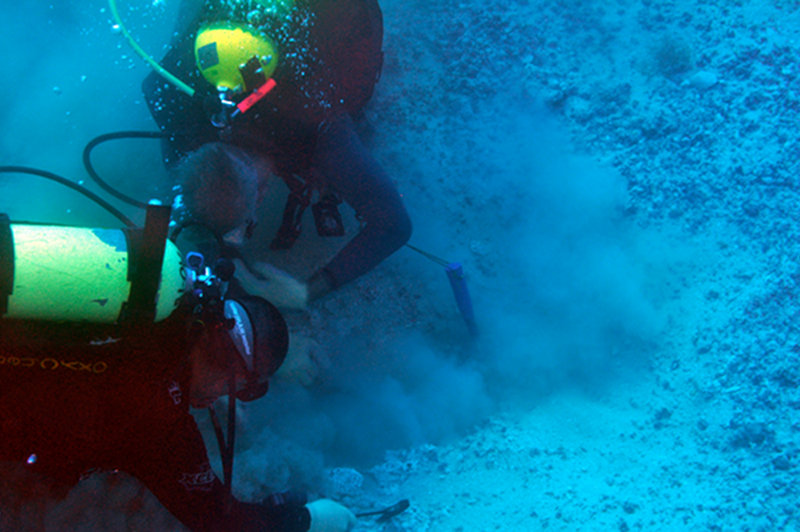
By J.M. Adovasio, Expedition Principal Investigator - Mercyhurst University
and C. Andrew Hemmings, Expedition Principal Investigator - Mercyhurst University
Underwater archaeological excavation is very similar to traditional land archaeology. We use similar tools but usually the plastic version of the tool so that it does not fall apart in the salt water. The archaeological goal of excavating materials in a controlled fashion where the original location of each object or artifact can be recorded and analyzed later is the same wherever you dig. The methods employed as we work underwater are slightly different because of the environment and the need for some different tools.

In 2009, the Submerged New World team investigated several areas that have potential to contain deposits from the Late Pleistocene. This year the team will return to some of these ares to investigate them more thoroughly. C. Andrew Hemmings and Nicolas Alvarado dig a hole through old coral that covers the buried — and ancient — Suwannee River, about 75 miles offshore. Image courtesy of Exploring the Submerged New World 2012 Expedition, NOAA-OER. Download image (jpg, 5.0 MB).
Most “tools of the trade” used on terrestrial archaeological digs are used underwater in our excavations as well. Hand trowels, square units, clipboards, pencils, tape measures, and other hand tools are all used underwater to excavate sites as they are used on land. However, rather than shovel dirt into a bucket or wheelbarrow and bringing it to a fine screen to shake it, or wash it with water to remove the dirt, we use a 100ft hose connected to a large dredge engine with a pump that moves 600 gallons of water a minute to suck the seafloor sediments like a giant vacuum cleaner. The dredge tube brings the sediments from the bottom and deposits them on our 8 by 12 foot floating screen deck that has mesh as fine as 1/16th of an inch to catch even the smallest of artifacts or bone fragments.
Getting together the archaeologists with proper dive training and experience and all of the necessary underwater tools is very hard compared to typical land excavations. Most people are rather surprised to hear that it is actually easier to excavate underwater than on land once all of the preparations have been made. Underwater, we can float over the site and move in very close to any part of our excavation without actually ever touching it. Also, when used properly, the dredge can be used to move mountains of dirt or layers as thin as a single grain of sand depending on what is needed at that moment.
Organic material such as bone, plant fibers, seeds, branches, and an incredibly array of perishable technology is often better preserved underwater than it is on land. Well buried and undisturbed underwater sites provide very stable conditions which aid in preservation much like being in a very dry cave in some portions of the American Southwest. However, wet organic materials are very sensitive to light, movement, and chemical changes (such as being moved from salt to fresh water too quickly). Part of our excavation process includes being ready to stabilize and conserve materials in the field that are rarely found in dry sites. Typically, organic materials are brought to the surface and stabilized as soon as possible. This is doubly important if we hope to directly date the object with a radiocarbon assay. Ideally you do not want a specimen to be handled very much because of the movement and potential for exposure to chemicals in the air. Further, once the item is secured in water that will be stable often we will refrigerate it to prevent any further deterioration occurring.
Underwater archaeological work is similar to terrestrial excavation in many respects but requires the use of additional techniques and methods, particularly when sensitive organic materials are found that require special handling techniques and processing methods. The goals of archaeology remain the same wherever Paleoindian fieldwork is conducted- namely, we wish to learn more about our shared human past and how, and when, and where, people came to the New World and survived in a rapidly changing environment at the end of the Pleistocene.